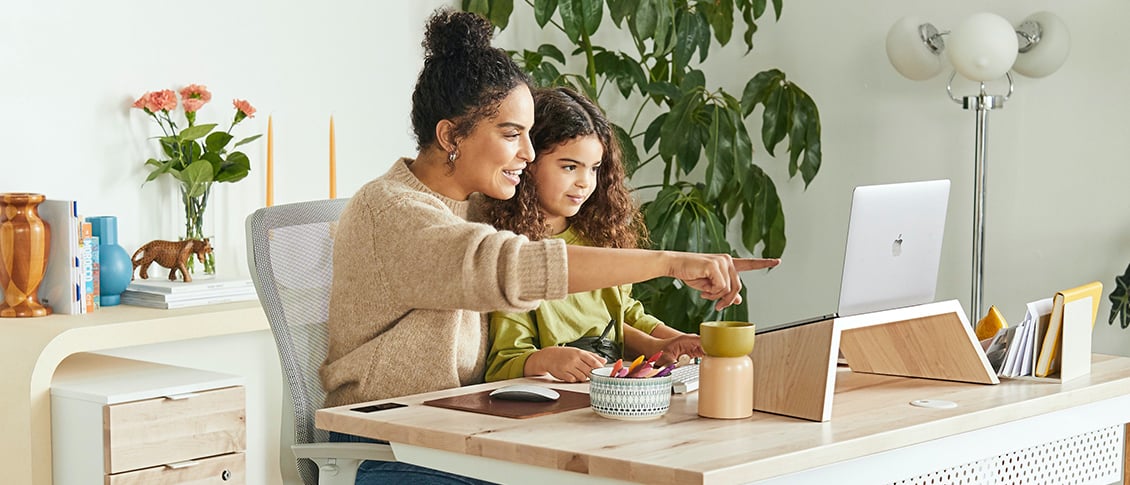How to Assess Your Home Office for Ideal Ergonomics
08.07.2021

A comfortable and organised space can set you up for the perfect day at work. It can be difficult to create a work from home office that you’re happy with. After all, with many people thrust into remote working, adapting to this change has been challenging.
Have you created a home working space but are struggling with aches and pains? Do you want to give your home office a makeover and increase your wellbeing? Whatever the reason, getting to grips with ergonomics can help banish discomfort and help you work efficiently.
What is ergonomics?
Before we reveal how you can self-assess your home office, it’s handy for you to understand what ergonomics actually is. Have you ever wondered why your office has certain chairs? Or why items are arranged in a certain way? This will be down to ergonomic design. It’s a process adopted by businesses to create and orchestrate products and systems for the benefit of their employees. The purpose of ergonomics is to increase efficiency and productivity whilst ensuring the wellbeing and comfort of all staff.
Ergonomic design doesn’t just influence the office you commute to. You can implement the same principles to your home office too. Below, we outline the different areas to focus on to bring your workspace in line with ergonomic best practice.

Assessing your office chair
Many of us are working from home using a dining chair, sofa, or beanbag as a makeshift office chair. If you’ve noticed back pain or joint issues it is likely due to your unsuitable seating arrangements. Ergonomic office chairs are widely available at various price points to suit your budget. You will need to source a chair that is fully adjustable so that you can manipulate the height, seat, and back tilt to suit your anatomy.
A perfectly modified office chair will enable you to have both feet flat on the floor, with your knees sitting lower than your hips. Your forearms should sit comfortably on your desk, producing an L shape with your upper arm.
If your chair needs refining, you can purchase products to help. Footrests and lumbar supports can be additional extras to ensure your body is in the best possible position.

Keyboard and mouse positioning
Maintaining a relaxed and neutral frame at your desk is important. You will want ergonomic accessories that facilitate your efforts to minimise injury. Your mouse and keyboard should be within easy reach without you having to stretch or strain to access them. Both pieces of equipment should be on the same surface to prevent issues such as carpal tunnel syndrome or computer elbow.
When using your computer or laptop aim to have your wrists straight and tuck your upper arms close to your body. Ideally, you will want your hands slightly below the level of your elbows. It can also be helpful to minimise mouse usage if possible, by employing the trackpad on your laptop or learning keyboard shortcuts.
When assessing your keyboard and mouse set up be aware of the following questions:
- Are you keyboard and mouse on the same work surface?
- Are your keyboard and mouse within easy reach?
- Is there ample space between the edge of your desk and the keyboard to comfortably rest your forearms?
- Are your wrists straight and shoulders relaxed when using your keyboard and mouse?
- Is your mouse at the same level as your elbow and as close to you as possible?
- Is your mouse comfortable to use?
- Does your keyboard pick up your keystrokes easily?
If you have an ergonomic setup, you will have answered yes to all these questions. Don’t panic if you have answered no to any of the above. There are plenty of ways to tweak your work station to make it ergonomically friendly. Sometimes it can be as simple as purchasing a keyboard wrist rest or an adjustable mouse pad to make yourself more comfortable.
Remote working screen placement
Whether you’re using a monitor or laptop, there are dos and don’ts when it comes to positioning your equipment. You will want to avoid headache inducing lighting and screen heights that put your neck at an unnatural angle.
Ideally you will place your screen directly in front of you, around an arm’s length away. The top of the screen should meet your eye level or sit slightly below. For those who wear bifocals, adjust this to be one or two inches lower as this will help with comfortable viewing. If you’re finding this difficult you can invest in an adjustable stand to raise or lower your monitor to the optimal level.
Screen placement isn’t the only thing that can cause issues for computer users when it comes to ergonomics. Lighting and screen glare can play havoc with productivity, causing headaches and migraines. Your monitor or laptop should not be positioned next to any windows or bright lighting sources. If you find yourself squinting or suffering from headaches you will need to remove lighting sources or close window blinds. Equally, if you need to read paper documents a lamp can be placed either directly left or right of your screen to prevent screen glare.

Ergonomic behaviours
Productivity and efficiency in your home office is not only affected by your equipment and surroundings. There are ways in which you act and behave that can be conducive to a great day at work. Taking breaks, particularly when you are glued to a screen for the majority of the day are highly important. Research suggests that a postural break every half an hour is important for your joints and mental clarity too. This could be making a drink or fetching something from the printer. This small amount of movement could save you from physical ailments in the future.
Similarly, resting your eyes from your screen is critical. Vision issues are rife amongst home workers as continued focus on a screen can causes blurred vision, eye strain, and headaches. Having a yearly eye test if you work on screens most of your working day is recommended.
Taking multiple screen breaks to focus on objects far away is advised. Furthermore, investing in some blue light reflecting glasses can be beneficial. Although scientific research is limited, some experts believe that exposure to blue light can damage the light-sensitive cells in the retina. If you’re concerned, blue light glasses can be picked up readily and are inexpensive.
An ergonomic office is just part of the puzzle to create a healthy working day. Diet, quality sleep, exercise, and the correct equipment all go hand in hand with ergonomic design to ensure you’re working productively. It pays to focus on your wellbeing when working from home so that you feel the best mentally and physically.